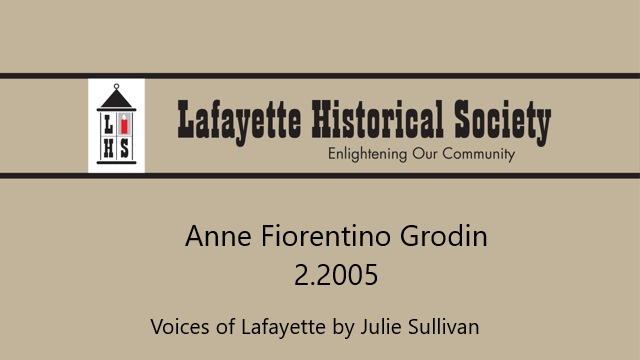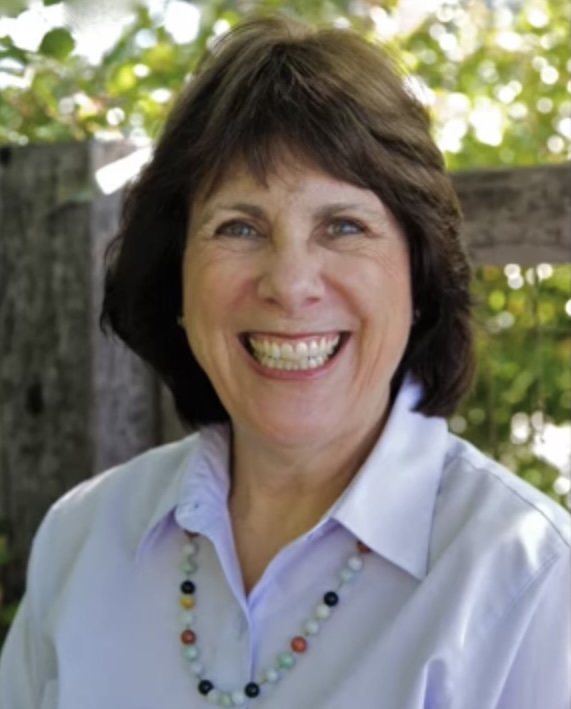Summary:
Anne Fiorentino Grodin was interviewed by Julie Sullivan in February, 2005. Anne describes how Lafayette grew and changed during the 50 years from 1955 to 2005. Along with other family members she helped operate Valley Disposal from 1979 to 1989, when the company was sold to Waste Management Inc. Soon afterwards she became active in city government, serving on the city council from 1991 to 1999 including two terms as mayor, and played a primary role in the creation of the Lafayette Library and Learning Center.
Oral History:
“Much of my story traces back to my father, Angelo Fiorentino,” Anne begins. Angelo immigrated to the United States at age four, in 1923, and built a successful business, living out the American Dream. “He arrived in Oakland from Bari, Italy, speaking no English. As a young Italian, it was natural that he find work with the other Italians who did the work that no one else would do. They were relegated to working at the garbage companies in Oakland and San Francisco. He was a mechanic and eventually a partner in Oakland Scavenger.”
After serving in World War II, Angelo and eight partners bought Valley Disposal in 1955. The company, which was located in Walnut Creek, picked up everything in the rural countryside from Pleasant Hill to Dublin, including Lafayette. Anne describes it as, “A mom and pop company with only four trucks. My father’s former partners in Oakland thought he was nuts for risking the financial future of his family coming out here to the other side of the tunnel!” Anne remembers. “Lafayette then was sort of like Antioch today, where there were brand new affordable homes in new subdivisions. Many of those who moved here were from Oakland, where homes were displaced by construction of the MacArthur Freeway. My friends who moved out here had horses and swimming pools, something we never had in Oakland. It was just a really different lifestyle, very rural.”
Anne’s first memories of Lafayette were of a long, strip city. “Bill’s Drugs was just about the biggest store in town. I remember Chap’s Drive-In restaurant that had the cowboy with the chaps in neon with the big sign (which the sign ordinance got rid of) and the big, tall sign El Charro restaurant used to have that you could see from the freeway. Cape Cod House was another institution that drew visitors from all over the East Bay.
“There used to be a lumber yard (Sun Valley Lumber Company) where the Lafayette Park Hotel is now,” she adds. “Mt. Diablo Boulevard was always pretty much smaller businesses, more a parking lot and asphalt look. There was a Swedish restaurant in an old house that was owned by the older sisters of one of my childhood friends, near where the Town Center apartments are now. Years later the house became the police station in what we used to call the ‘BART block.’ It was always fun when I was on the City Council and went up to that police station, remembering the Swedish restaurant that used to be there.”
At the time Anne’s father and his partners bought Valley Disposal, there were a couple of other companies in central county. “One was Diablo Disposal, near what later became Danville, and another was Lafayette Disposal, owned by Lou Repetto and Art DiGracia,” Anne explains. “Valley Disposal was headquartered on North Main in Walnut Creek. Lafayette Disposal was headquartered in Lafayette for years. Valley bought Diablo Disposal and Lafayette Disposal in 1977, and the offices were consolidated in Walnut Creek.
“Orinda-Moraga Disposal parked its trucks on Blackwood Lane in Lafayette, behind Butler-Conti Dodge. People often called our offices to complain about the noisy trucks, and we would have to explain that they belonged to another company.”
Anne and her husband, Marshall, were married in 1968, when they were seniors at Berkeley. Both took a course from Robert Fisher, who was active in the drive to incorporate Lafayette. Anne volunteered on Fisher’s campaign, and he became her mentor. Marshall’s work for the J. P. Scripps newspaper chain led to a number of moves within California. He later became editor of the San Ramon Valley Herald in Danville. Anne returned to school to get a law degree.
Along with her mother, Fran, Anne became involved in running Valley Disposal in late 1979. Marshall joined the company in 1982. Anne’s father passed away in 1983. “We expanded the company by winning the contract to serve the newly incorporated City of San Ramon,” Anne explains. “The three of us ran the company until we sold it to Waste Management , an international corporation, in 1989.Thirty- five years after my father originally bought the company, it had grown to 100 trucks and 150 employees.”
Marshall and Anne moved to Lafayette in 1984, but even before that she was active in the Lafayette Chamber of Commerce, because Valley Disposal’s service area included Lafayette. “I already knew a lot about Lafayette from my work with the Chamber, and we liked living in the area our business served.
“Originally, downtown Lafayette was not as attractive as it is now,” Anne says. “We didn’t have a lot of trees, and downtown was kind of shabby in some places. There were older buildings that hadn’t been maintained. It was like they were waiting for the next wave of things to happen. People didn’t want Lafayette to grow as fast as Walnut Creek, where the downtown was starting to really boom. Lafayette wanted to keep our town more semi-rural.
“The city incorporated in 1968 to gain planning control and avoid having big changes happen here. It took a while for the planning commission and the city to figure out what they wanted. There were height restrictions on buildings, and it was easy for the development to go some place else, which was good for us in the long run.
“We used to have the La Fiesta Day Parades sponsored by the Chamber of Commerce every fall. They had been going on for years, probably more than 50 years. They were horse-sanctioned parades, and people came from all over. Charmian Dobell and I chaired the last one around 1990. It cost around $1,000 to put on, which was expensive then, and it took one or two people a whole year to organize. Art & Wine has replaced the parades, but I still miss them.”
Anne was a member of the Chamber board, then president in the mid to late 1980’s. She ran and lost on her first try for City Council in 1989, and then won in 1991 with the highest vote count and served eight years, twice as mayor. She went off the council in 1999.
“I think our major accomplishments were the downtown landscaping, the new street lights, and the school buses. The buses reduced traffic five per cent. Lafayette residents don’t want freeways, so we didn’t widen Moraga Road or Moraga Way. But we had to find a way to reduce traffic on our roads. I was especially pleased when I read a Chronicle article recently that called us Leafy Lafayette.”
Anne’s other accomplishment was planning for the new library. The original cement block building opened in 1962. By 1969 it had outgrown its space. Currently it has 6,000 square feet, and the new library will have 28,000 square feet.
In thinking about Lafayette’s future, Anne envisions more retail downtown, new off-street parking as part of the retail development, and sidewalks and trees in the East End. “Whenever I go shopping downtown or walk the Reservoir, I always see people I know. That’s what I love most about Lafayette. It’s still a small town, with friendly people who care deeply about it.”
Excerpted from “Voices of Lafayette” by Julie Sullivan. This book is available for purchase in the History Room.



I think that Anne Grodin is a LLT, a Lafayette Living Treasure.